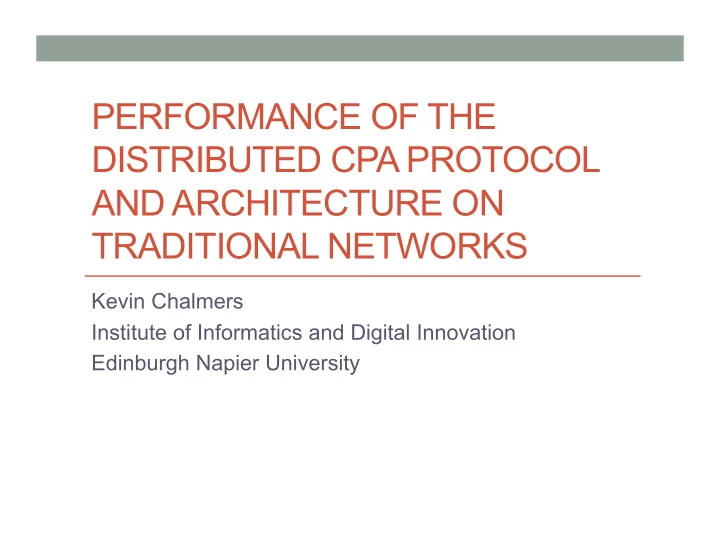

PERFORMANCE OF THE DISTRIBUTED CPA PROTOCOL AND ARCHITECTURE ON TRADITIONAL NETWORKS Kevin Chalmers Institute of Informatics and Digital Innovation Edinburgh Napier University
Breakdown • Background • And why we haven’t got occam- π networking working yet • Network performance • Latency • Throughput • Mandelbrot performance • Conclusion and future work
What I hoped to be talking about today… • occam- π talking to JCSP talking to PyCSP • This is possible • occam- π version very unstable • occam- π version very inefficient • Something interesting using this setup on an HPC • JCSP is good for user interfaces • PyCSP good for scripting • occam- π good for heavy lifting
Background • On-going work on a unified protocol and architecture for CPA based distributed computing • Once I have this, I can move back to getting mobility built into the protocol • JCSP Net 2.0 package has been around for a few years now • 2008 • Previously we have only looked at mobile device communication using JCSP Net 2.0 • Upgrade to CSP for .NET 2.0
Problem with occam • Networking architecture relies on a number of dynamically sizing lookup tables internally • Channel lookup table • Barrier lookup table • Link lookup table • Channels and barriers are created with an indexing value in the range 0 to 2 32 -1 • This can be defined by the application programmer • occam currently doesn’t allow complex data structures easily • Going into native code an option
Tests Performed • We are looking at general network performance using the CPA architecture • Network latency • Network throughput (unidirectional and bidirectional) • Baseline network, CSP Sync and CSP Async gathered • We are also going to do a naïve (non-optimised) distributed Mandelbrot • Results gathered using both JCSP and CSP for .NET 2.0
Experimental Framework • Experiments were performed in a standard computing lab • Machines specs • Intel Core Duo E8400 3.0 GHz (no hyper-threading) • 2 GB RAM • Windows 7 32-bit • .NET 3.5, Java 6 • Network • 100 Mbps switched Ethernet
Ping Times
Sending Times
Throughput
Send-Receive Times
Send-Receive Throughput
Mandelbrot • Producing 3500 x 2000 pixel bitmaps representing parts of the Mandelbrot set • Split a single image into multiple parts • Scaling the set to produce multiple bitmaps • 2 x scale = 4 parts (7000 x 4000 total image size) • 3 x scale = 9 parts (10500 x 6000 total image size) • etc. • Using the escape time algorithm
Mandelbrot Tiling
Mandelbrot Architecture
Mandelbrot Results
Throughput Scale Data Points Bytes DP / s Bytes / s 1 7 x 10 6 2.8 x 10 7 3.25 x 10 5 1.3 x 10 5 2 2.8 x 10 7 1.12 x 10 8 6.67 x 10 5 2.66 x 10 6 3 6.3 x 10 7 2.52 x 10 8 8.04 x 10 5 3.21 x 10 6 4 1.12 x 10 7 4.48 x 10 8 8.04 x 10 5 3.22 x 10 6 5 1.75 x 10 8 7 x 10 8 8.46 x 10 5 3.38 x 10 6 6 2.52 x 10 8 1.01 x 10 9 8.65 x 10 5 3.46 x 10 6 7 3.43 x 10 8 1.37 x 10 9 8.69 x 10 5 3.47 x 10 6 8 4.48 x 10 8 1.79 x 10 9 8.71 x 10 5 3.48 x 10 6
Future Work • Currently working on a C++CSP version of the network architecture • All CSP based libraries can plug-in and use • Hopefully finished towards the end of summer • Will not be in an optimised state • Tackle some good problems with this on an HPC • Comparison work against MPI, Erlang, etc. • Mobility built into the protocol • Still no “ideal” solution
Conclusion • We have inter-framework communication • Granted only between JCSP and CSP for .NET • occam- π has a few problems when implementing the architecture we want • C++CSP networking should solve this • Distributed CPA protocol and architecture gives performance comparable to the baseline network • Particularly at large data sizes and back and forth communication • Some speedup when performing Mandelbrot – but not much • Naïve Mandelbrot implementation
QUESTIONS? Thanks to Julien Mateos for his work on CSP for .NET 2.0, and his current work on implementing networking for C++CSP
Recommend
More recommend